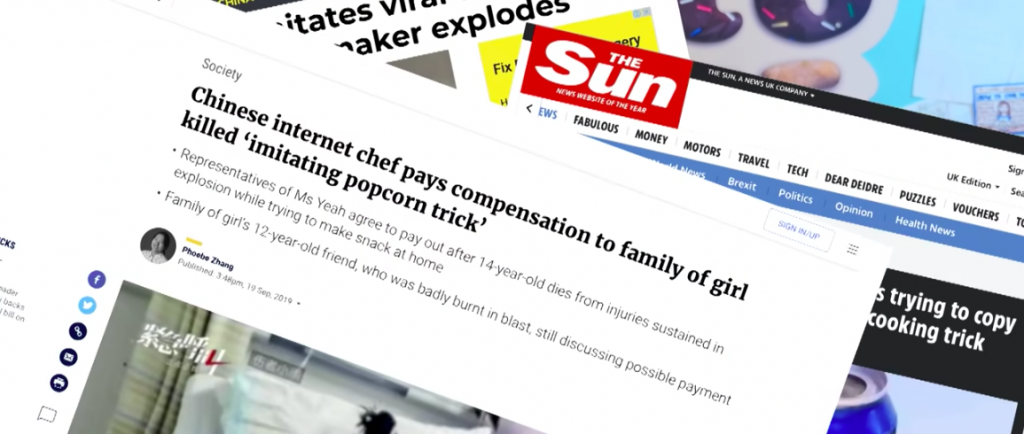Recently, I’ve stumbled upon a heated discussion online on whether YouTube should be involved in monitoring content that the users of the platform are posting. In this blog post, I will look into life-hack channels with millions of subscribers and their impact on society.

I used to constantly watch life hack videos when they just emerged about eight years ago and even tried some of the tips and tricks which have worked well for me. But it was not entertaining enough or useful for me to keep being engaged with the content so I stopped watching. When the 5-minute Crafts realized that people are less interested in useful content and it requires way too much time to find a ‘hack’ that actually works, they started to experiment with the boundaries of the rules of YouTube. And it did not take long for the 5-Minute Crafts channel to realise the power of the thumbnail, the good SEO and the clickbait techniques. For those that are unfamiliar with these things, I will keep it short and simple: they generate more clicks, therefore more views and then the content is catchy enough to keep the viewer engaged for more minutes – all of these things together generate money. The better the strategy – the more income the creator receives. The incomes of YouTube channels fluctuate constantly because YouTube is constantly changing its algorithms. More about that later.
The rules of YouTube are too long to list, but here are the main points:
- No porn
- No copyright music
- No copying other videos
- And other mostly copyright-related rules
The life hack channels quickly realized that the rules of the platform do not require the content to be true or to transmit the facts. It is hard to find out what the truth is and what is not, since YouTube provides everyone with the voice and censorship does not work well when everyone is given an option to express their opinions. Therefore, the life hack channels started to produce hacks that look appealing, aesthetic, shocking, and most importantly ‘work like magic’. For example, pouring vodka on candies to make a colorful lemonade for children, putting strawberries into the bleach to make them white and more. For us, it might seem obvious that things like these do not work, are absurd and that we will not waste our time trying them. However, kids and young teens have unlimited access to videos like these, because as it was mentioned before, the videos are 100% suitable to be shown (and promoted) to children who are known for their lack of critical thinking, according to the rules of YouTube. Therefore everyone is exposed to fake life hacks. This has resulted in a lot of funny accidents that kids will remember and laugh about with their friends but it has also resulted in dangerous situations, that sometimes, ended up being fatal.
On September 5th, 2019 two girls in China tried a life hack that they saw a popular blogger Ms Yeah demonstrate. The hack promised to make popcorn inside of the aluminum can. It involved putting popcorn into the can, heat it up and watch it make popcorn. In short, the problem occurred when girls decided to use alcohol to heat the aluminum can, instead of the candle that could be safer. The alcohol caught fire and the bottle with alcohol exploded which killed one of the girls and put the other one into the hospital. The minute this story appeared online, Ms Yeah was immediately blamed for the tragedy, people were calling her a murderer and she started to receive death threats. She was forced to take responsibility and apologize, however, she did state that the girls were using a different method than she did.
Watching the videos that have millions of views and promise to hack/help your life is different than watching a video that has fewer views. The view count gives the authority to the content, and since no one is reporting the videos they are being not only shown but actively promoted by YouTube. The algorithm of YouTube considers these videos ‘very important’ for people to see: they have a lot of views, CPI is high, viewing duration is also high, and majority of the views come from Western countries – all of this, contributes to the promotion of the video and income that the channels are receiving.
The main question, however, remains – who is responsible for potentially dangerous content? If artificial intelligence considers these videos important for society, censorship is unwelcome, people do not report the videos because they are entertaining, then how can there be a solution to this? The responsibility for the problems occurring after trying the hack is a very tricky question – is it a platform (YouTube) that not only allows these videos but also promotes content like that, or channels like 5-Minute Crafts that know that their hacks do not work and are not real or people who try the hacks at home? This definitely opens a discussion and the solution is unclear. With the rise of the videos that debunk the DIY hacks, YouTube might look into the problem and we might have ideas on how to solve it soon.


I have definitely watched these videos and used some of the tricks, and it’s suprising how many of these tricks are simply wrong, or as you showed even dangerous at some times. Algorithms would be the solution to filtering these videos because often there are multiple “hacks” where some are true and others are not. On the other hand I also don’t believe that deleting videos/posts containing blantant misinformation should be considered censorship, especially not when they contain dangerous materials. Because misinformation is not an opinion or free speech.
I love the debunking videos that tear these terrible tricks apart. Ann Reardon is great and explains the how and why so well